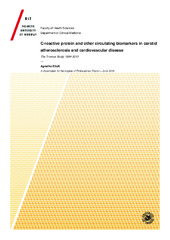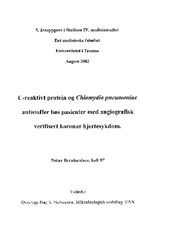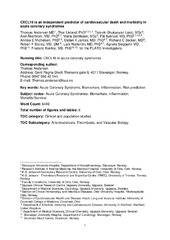Blar i tittel Det helsevitenskapelige fakultet
Viser treff 1101-1120 av 10096
-
C-reactive protein and its associations with сardiometabolic risk factors and echocardiographic indicators of heart failure: results of “Know your heart” study in Arkhangelsk
(Journal article; Tidsskriftartikkel; Peer reviewed, 2020-09)<p><i>Цель - </i>Оценка связи высокочувствительного С-реактивного белка (вчСРБ) с кардиометаболическими и эхокардиографическими (ЭхоКГ) индикаторами сердечной недостаточности (СН) среди взрослого населения Северного региона России. <p><i>Материал и методы - </i>Поперечное исследование «Узнай свое сердце» проведено в 2015–2017 гг. на случайной выборке общего населения г. Архангельска в возрасте 35–69 ... -
C-reactive protein and other circulating biomarkers in carotid atherosclerosis and cardiovascular disease. The Tromsø Study 1994-2013
(Doctoral thesis; Doktorgradsavhandling, 2018-11-07)Hjerte- og karsykdom er ledende årsak til død og sykelighet på verdensbasis. I Norge er det årlig ca. 13 000 hjerteinfarkt og 12 000 hjerneslag. Til tross for at den forebyggende og akuttmedisinske behandlingen er betydelig forbedret i løpet av de siste 30 år, forventes en fortsatt økning i hjerte- og karsykdommer på verdensbasis. De tradisjonelle risikofaktorene (alder, kjønn, blodtrykk, kolesterol, ... -
C-reactive protein and risk of venous thromboembolism: Results from a population-based case-crossover study
(Journal article; Tidsskriftartikkel; Peer reviewed, 2018-04-19)Long-term, low-grade inflammation does not seem to be a risk factor for venous thromboembolism. The impact of acute inflammation, regardless of cause, on risk of venous thromboembolism is scarcely studied. We aimed to investigate the impact of acute inflammation, assessed by C-reactive protein, on short-term risk of venous thromboembolism. We conducted a case-crossover study of patients with venous ... -
C-Reactive Protein and TGF-α Predict Psychological Distress at Two Years of Follow-Up in Healthy Adolescent Boys: The Fit Futures Study
(Journal article; Tidsskriftartikkel; Peer reviewed, 2022-03-11)Objective: The scarcity of research on associations between inflammatory markers and symptoms of depression and anxiety during adolescence has yielded inconsistent results. Further, not all studies have controlled for potential confounders. We explored the associations between baseline inflammatory markers and psychological distress including moderators at follow-up in a Norwegian adolescent population ... -
C-reactive protein levels and depression in older and younger adults - A study of 19,947 individuals. The Tromsø study
(Journal article; Tidsskriftartikkel; Peer reviewed, 2022-12-17)In recent years, a connection between depression and inflammation has been established, with a range of immunological changes, both cellular and humoral, presenting during depressive states (Beydoun et al., 2016; Haapakoski et al., 2015; Wium-Andersen et al., 2013). Furthermore, there seems to be a dose-response relationship between depression and inflammation, in the sense that the more severe the ... -
C-reactive protein point-of-care testing and antibiotic prescribing for acute respiratory tract infections in rural primary health centres of North Ethiopia: A cross-sectional study
(Journal article; Tidsskriftartikkel; Peer reviewed, 2016-01-14)Unjustified antibiotic prescribing for acute upper respiratory infections (URTIs) is probably more common in poor-resource settings where physicians are scarce. Introducing C-reactive protein (CRP) point-of-care testing in such settings could reduce the misuse of antibiotics, which could avert antibiotic resistance. However, information useful for the applicability of CRP test in resource-limited ... -
C-reactive protein point-of-care testing and complementary strategies to improve antibiotic stewardship in children with acute respiratory infections in primary care
(Journal article; Tidsskriftartikkel; Peer reviewed, 2023-10-12)This paper provides the perspective of an international group of experts on the role of C-reactive protein (CRP) point-of-care testing (POCT) and complementary strategies such as enhanced communication skills training and delayed prescribing to improve antibiotic stewardship in the primary care of children presenting with an acute illness episode due to an acute respiratory tract infection (ARTI). ... -
C-reactive protein point-of-care testing for safely reducing antibiotics for acute exacerbations of chronic obstructive pulmonary disease: The PACE RCT
(Journal article; Tidsskriftartikkel; Peer reviewed, 2020-03)Background - Most patients presenting with acute exacerbations of chronic obstructive pulmonary disease (AECOPD) in primary care are prescribed antibiotics, but these may not be beneficial, and they can cause side effects and increase the risk of subsequent resistant infections. Point-of-care tests (POCTs) could safely reduce inappropriate antibiotic prescribing and antimicrobial resistance.<p> ... -
C-reactive protein testing to guide antibiotic prescribing for COPD exacerbations
(Journal article; Tidsskriftartikkel; Peer reviewed, 2019-07-11)<i>BACKGROUND</i> - Point-of-care testing of C-reactive protein (CRP) may be a way to reduce unnecessary use of antibiotics without harming patients who have acute exacerbations of chronic obstructive pulmonary disease (COPD).<p><p> <i>METHODS</i> - We performed a multicenter, open-label, randomized, controlled trial involving patients with a diagnosis of COPD in their primary care clinical ... -
C-reactive protein-guided antibiotic prescribing for COPD exacerbations: A qualitative evaluation
(Journal article; Tidsskriftartikkel; Peer reviewed, 2020-06-25)Background - Antibiotics are prescribed to >70% of patients presenting in primary care with an acute exacerbation of chronic obstructive pulmonary disease (AECOPD). The PACE randomised controlled trial found that a C-reactive protein point-of-care test (CRP-POCT) management strategy for AECOPD in primary care resulted in a 20% reduction in patient-reported antibiotic consumption over 4 weeks.<p> <p>Aim ... -
C-reaktivt protein og Chlamydia pneumoniae antistoffer hos pasienter med angiografisk verifisert koronar hjertesykdom
(Master thesis; Mastergradsoppgave, 2002-08) -
C-X-C ligand 16 is an independent predictor of cardiovascular death and morbidity in acute coronary syndromes
(Journal article; Tidsskriftartikkel; Peer reviewed, 2019-09-26)<i>Objective:</i> - The chemokine CXCL16 (C-X-C motif ligand 16) is a scavenger receptor for OxLDL (oxidized low-density lipoproteins) and involved in inflammation at sites of atherosclerosis. This study aimed to investigate the association of CXCL16 with clinical outcome in patients with acute coronary syndrome.<p> <p><i>Approach and Results:</i> - Serial measurements of CXCL16 were performed ... -
C1 inhibitor deficiency enhances contact pathway–mediated activation of coagulation and venous thrombosis
(Journal article; Tidsskriftartikkel; Peer reviewed, 2023-05-11)C1 inhibitor (C1INH) is a multifunctional serine protease inhibitor that functions as a major negative regulator of several biological pathways, including the contact pathway of blood coagulation. In humans, congenital C1INH deficiency results in a rare episodic bradykinin-mediated swelling disorder called hereditary angioedema (HAE). Patients with C1INH deficiency–associated HAE (C1INH-HAE) have ... -
C1-inhibitor. Betydning i sykdom og terapi -Et narrativt litteraturstudium belyst med publikasjoner av T.E Mollnes, E.W. Nielsen og medarbeidere ved immunologisk forskningslaboratorium Nordlandssykehuset Bodø
(Master thesis; Mastergradsoppgave, 2017-09-18)Formålet med denne oppgaven er todelt. Hoveddelen av oppgaven er et narrativt litteraturstudium med mål å få en bred og god forståelse for hvilken struktur og funksjon C1-inhibitor har, hvilken effekt proteinet har i de ulike kaskadesystemene i kroppen hvor proteinet inngår som en regulator, samt hvilken rolle proteinet spiller i patogenesen ved hereditært angioødem, alt dette belyst med publikasjoner ... -
Cabazitaxel-loaded Poly(2-ethylbutyl cyanoacrylate) nanoparticles improve treatment efficacy in a patient derived breast cancer xenograft
(Journal article; Tidsskriftartikkel; Peer reviewed, 2018-12-04)The effect of poly(2-ethyl-butyl cyanoacrylate) nanoparticles containing the cytotoxic drug cabazitaxel was studied in three breast cancer cell lines and one basal-like patient-derived xenograft model grown in the mammary fat pad of immunodeficient mice. Nanoparticle-encapsulated cabazitaxel had a much better efficacy than similar concentrations of free drug in the basal-like patient-derived xenograft ... -
Cabin temperature during prehospital patient transport – a prospective observational study
(Journal article; Tidsskriftartikkel; Peer reviewed, 2020-07-13)<i>Background</i> - Few studies have investigated the patient compartment temperatures during ambulance missions or its relation to admission hypothermia. Still hypothermia is a known risk factor for increased mortality and morbidity in both trauma and disease. This has special relevance to our sub-arctic region’s pre-hospital services, and we prospectively studied the environmental temperature in ... -
Cabin temperature during prehospital patient transport – a prospective observational study from Northern Norway
(Master thesis; Mastergradsoppgave, 2019-11-01)Background Few studies have investigated the patient compartment temperatures during ambulance missions or its relation to admission hypothermia. Still hypothermia is a known risk factor for increased mortality and morbidity in both trauma and disease. This has special relevance to our sub-arctic region’s pre-hospital services, and we prospectively studied the environmental temperature in the patient ... -
Caesarean section rates and activity-based funding in Northern Norway: A model-based study using the World Health Organization's recommendation
(Journal article; Tidsskriftartikkel; Peer reviewed, 2018-07-16)<i>Objective</i>: Caesarean section (CS) rates vary significantly worldwide. ,e World Health Organization (WHO) has recommended a maximum CS rate of 15%. Norwegian hospitals are paid per CS (activity-based funding), employing the diagnosis-related group (DRG) system. We aimed to document how financial incentives can be affected by reduced CS rates, according to the WHO’s recommendation. <p> <p> ... -
The Cafeteria Diet: a standardized protocol and its effects on behavior
(Journal article; Tidsskriftartikkel; Peer reviewed, 2020-12-10)Obesity is a major health risk, with junk food consumption playing a central role in weight gain, because of its high palatability and high-energy nutrients. The Cafeteria (CAF) diet model for animal experiments consists of the same tasty but unhealthy food products that people eat (e.g. hot dogs and muffins), and considers variety, novelty and secondary food features, such as smell and texture. ... -
Caffeine and primary (migraine) headaches-friend or foe?
(Journal article; Tidsskriftartikkel; Peer reviewed, 2019-12-03)<i>Background</i>: The actions of caffeine as an antagonist of adenosine receptors have been extensively studied, and there is no doubt that both daily and sporadic dietary consumption of caffeine has substantial biological effects on the nervous system. Caffeine influences headaches, the migraine syndrome in particular, but how is unclear.<p> <p><i>Materials and Methods</i>: This is a narrative ...


 English
English norsk
norsk


















